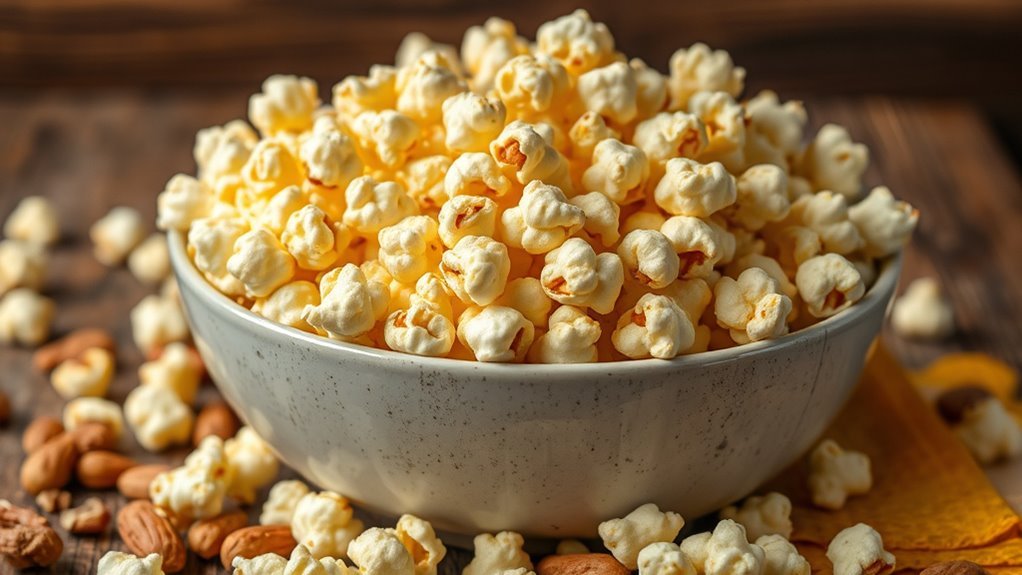Popcorn’s carbohydrate content makes it a tricky snack choice for the keto diet. A standard serving of air-popped popcorn has about 15 grams of carbs, which can take up a significant portion of your daily limit. If you choose to enjoy it, stick to smaller portions, ideally 1-2 cups. Alternatives like cheese crisps or nut mixes may better fit your keto goals. Discover other insights on making healthier snack choices while sticking to your carb limits.
Understanding the Carb Content of Popcorn

When it comes to understanding the carb content of popcorn, it’s essential to recognize that a standard serving of air-popped popcorn (about 3 cups) contains roughly 15 grams of carbohydrates. While this may not seem high, it’s important to take into account the type of popcorn varieties you choose. Different popcorn sources can have varying carb levels, especially when flavored or combined with oils and butter. For instance, kettle corn can greatly increase carb content due to added sugars. If you’re looking for a low-carb snack, sticking to air-popped versions is your best bet. This way, you can enjoy popcorn without straying too far from your dietary goals, maintaining that sense of freedom in your food choices.
The Keto Diet Basics: What You Need to Know

Understanding the carb content of popcorn sets the stage for maneuvering the keto diet effectively. To embrace the keto fundamentals and navigate your dietary restrictions, keep these key points in mind:
- The goal is to limit carbs to about 20-50 grams per day.
- Focus on high-fat, moderate-protein foods for energy.
- Incorporate non-starchy vegetables to maintain nutrient balance.
- Stay hydrated; water’s essential for overall health on keto.
- Monitor your body’s responses to adjust your diet as needed.
Is Popcorn Compatible With a Keto Lifestyle?

When considering popcorn on a keto diet, it’s crucial to look at its carbohydrate content, as it can quickly add up and impact your daily limits. While popcorn might not be the most keto-friendly snack due to its carbs, there are alternative snack options that can keep you within your macros. Let’s explore these factors to see if popcorn can fit into your keto lifestyle.
Carbohydrate Content Analysis
Although popcorn is often seen as a beloved snack, its compatibility with a keto lifestyle can be tricky due to its carbohydrate content. Here’s a quick breakdown of what you need to know:
- Carbohydrates: A typical serving of popcorn can contain around 15-30 grams of carbs.
- Popcorn Varieties: Different types, like buttered or kettle corn, can alter carb levels.
- Fiber Content: While popcorn does provide some fiber, it may not offset the carb count effectively.
- Serving Size: Portion control is essential; even a small bowl can add up.
- Alternatives: Consider lower-carb snacks if you’re strictly following keto.
Ultimately, moderation is key if you crave popcorn, but it may not fit seamlessly into your daily carb limits.
Alternative Snack Options
While popcorn might tempt you as a snack option, there are several alternatives that align better with a keto lifestyle. For satisfying keto snacks, consider healthy crunches like cheese crisps, which provide that crispy texture without the carbs. Nut mixes are also great low carb options, offering protein and healthy fats to keep you energized. If you’re craving something savory, veggie chips can satisfy your snack attack while keeping your carb count in check. Additionally, seed snacks, such as roasted pumpkin or sunflower seeds, deliver a nutritious crunch that complements your diet. With these alternatives, you can enjoy delicious treats while staying true to your keto goals, giving you the freedom to indulge without the guilt.
Nutritional Breakdown: Popcorn vs. Keto-Friendly Snacks
Popcorn might seem like a harmless snack, but when you compare its nutritional profile to that of keto-friendly alternatives, the differences become clear. While popcorn varieties can be enticing, they typically contain higher carbs than you’d want on a keto diet. Here are some snack comparisons to evaluate:
Popcorn may seem innocent, but its higher carb content can disrupt your keto diet compared to better snack options.
- Popcorn: About 6 grams of net carbs per cup
- Cheese Crisps: Roughly 1 gram of net carbs per serving
- Veggie Chips: Approximately 5 grams of net carbs per serving
- Nuts: Around 3-4 grams of net carbs per ounce
- Pork Rinds: Virtually zero carbs
Ultimately, making informed choices can help you maintain your keto lifestyle while enjoying satisfying snacks that align with your goals.
Portion Control: How Much Popcorn Can You Enjoy?
When considering snacks that fit within a keto diet, portion control becomes paramount, especially with popcorn’s relatively high carbohydrate content. To enjoy popcorn while staying within your carb limits, it’s essential to monitor popcorn portions closely. A typical serving size of air-popped popcorn is about 1 cup, which contains approximately 6 grams of carbs. If you want to indulge, consider limiting yourself to one or two servings, ensuring you account for these carbs in your daily intake. Finding the right balance allows you to enjoy popcorn without derailing your keto goals. Remember, it’s all about moderation—savor the crunch while staying mindful of portion sizes to maintain your freedom on this diet.
Tasty Alternatives to Popcorn on Keto
If you’re looking for tasty alternatives to popcorn on a keto diet, you’re in luck, as there are plenty of satisfying snacks that can keep your cravings at bay without pushing you over your carb limit. Here are some delicious options to evaluate:
- Keto chips: Crunchy and flavorful, these chips are made to fit your keto lifestyle.
- Cauliflower popcorn: A light and airy snack that mimics popcorn without the carbs.
- Cheese crisps: Baked or fried cheese that delivers a satisfying crunch and loads of flavor.
- Pork rinds: A classic keto favorite, great for dipping or snacking alone.
- Zucchini chips: Baked or fried, these offer a unique twist on savory snacking.
These alternatives are not just tasty; they also keep you aligned with your keto goals!
Tips for Staying on Track With Your Keto Goals
Staying on track with your keto goals can be easier with effective meal planning strategies, smart snack alternatives, and accurate macro tracking. By preparing your meals in advance, you’ll reduce the temptation to stray from your diet. Additionally, finding satisfying snacks and keeping a close eye on your macronutrients will help you maintain your progress.
Meal Planning Strategies
Although meal planning might seem intimidating at first, it’s one of the most effective strategies for successfully adhering to your keto diet. By organizing your meals, you’ll have more freedom to enjoy your food while staying on track. Here are some tips to enhance your meal prep:
- Plan your grocery shopping to avoid impulse buys.
- Use ingredient swaps to incorporate low-carb alternatives.
- Monitor portion sizes to maintain your macros.
- Experiment with flavor enhancements for satisfying meals.
- Create recipe modifications for variety in your meals.
With these strategies, you’ll find it easier to maintain your keto lifestyle, explore delicious snack ideas, and enjoy meal variations without feeling restricted. Embrace the journey and savor the freedom of delicious options!
Snack Alternatives Suggestions
With well-organized meals in place, it’s important to contemplate your snack choices to keep your keto goals on track. Opt for nutrient dense options that align with your low carb lifestyle. Instead of popcorn, consider crunchy alternatives like cheese crisps or roasted nuts, which provide satisfying treats without the carbs. You can also enjoy fiber rich choices like celery with almond butter or cucumber slices topped with cream cheese for savory bites. Don’t forget to explore healthy swaps, such as kale chips or pork rinds, which can serve as keto friendly munchies. These options will keep your cravings at bay while ensuring you stay focused on your diet. Remember, snacking smartly can make all the difference!
Tracking Macros Effectively
Success on the keto diet relies heavily on meticulous tracking of your macronutrients. To stay on track with your goals, effective logging is crucial. Here are some tips to help you with macro tracking:
- Use a reliable app to log your food intake.
- Measure your portions accurately to avoid guesswork.
- Read food labels carefully to understand carb content.
- Plan your meals in advance to guarantee you stay within your limits.
- Reflect on your progress weekly to adjust as needed.


